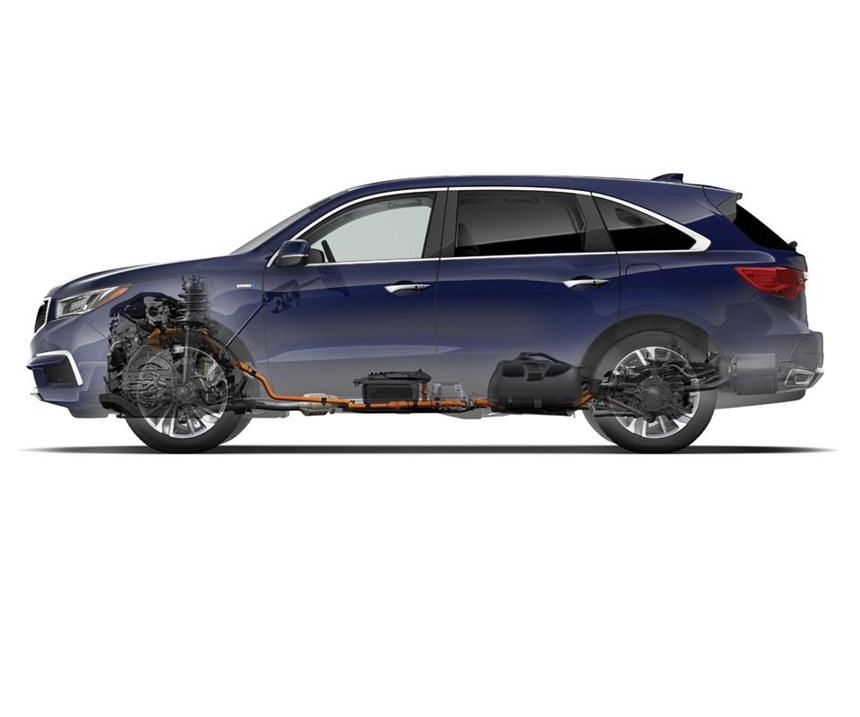The 2017 MDX Sport Hybrid & the Transformation of Acura
As Gary Robinson, manager of Acura Product Planning, puts it, “We are Honda’s performance brand. That is something we take very seriously.” Yes, even when developing a hybrid.
An SUV hybrid.
#Acura #hybrid
Jon Ikeda, a graduate of Art Center, has been with Honda since 1989. He recalls that back then, the freshly minted graduate who was likely to take up a design position with one of the Detroit-based car companies, took a trip to Japan, which he thought would be a short visit. It wasn’t. He ended up working in Japan, at what was then a fairly new advanced design studio that Honda had established in Tokyo, for six years.
One of the factors that led him to visit was a curiosity to discover who it was that was producing vehicles like the early Acuras: the Legend, the Integra. Another factor was an abiding interest in motor racing, and, yes, his hosts took him to a circuit with all-access capability.
That pretty much sealed the deal.
Of that period, Ikeda says, “The passion, the energy and the vitality were incredible.”
There, he worked on concepts like the Honda FSX show car and the 1996 production Acura RL.
He moved back to the U.S., taking a position with Honda R&D Americas in Torrance, southwest of downtown L.A.
Ikeda worked there for 15 years, during which time, among other things, he was design project leader for the 2001 Civic Coupe and headed up the design activities for the 2004 Acura TL. From 2004 on Ikeda focused on designing Acura products.
Just how much he focused on Acura is manifest in his present position, which he attained in July 2015: vice president and general manager of the Acura Division of American Honda Motor Company, Inc.
That’s right. He’s the guy in charge.
Or, as Ikeda modestly puts it, “About a year-and-a-half ago they moved me over the fence to do what I think is needed for the Acura brand.”
And what Ikeda thinks is needed goes back to his days in Japan, where he thought that there was a great deal of enthusiasm for creating great-looking cars (yes, it was about cars back then, sedans and coupes and that nascent NSX, the first generation of which appeared in the U.S. in 1990) that had performance chops.
“We are trying to get back to our roots,” Ikeda says. And those roots are fairly well encapsulated by what is nominally a tagline used by Acura: “Precision Crafted Performance.”
But Ikeda says, “It’s not just a tagline. We are the performance division of Honda,” adding, “And if we’re going to talk about performance, one of the key cornerstones is that we have a sports car.” He’s talking, of course, about the NSX, the second generation, in particular, which launched last year. He goes on to point out that if they’re going to have a sports car, then they need to go racing. So they’re campaigning the NSX GT3 at places like Sebring and Daytona. (His hosts in Japan in ’89 tapped into Ikeda’s interest in racing, something that continues on with passion.)
It is interesting to note that Ikeda mentions Honda inasmuch as the mother companies for the likes of Lexus and Infiniti—and arguably heretofore Acura—are rarely mentioned. Yet Honda is certainly one of the most superb manufacturers on the planet, so if you’re going to be producing something—as in the “Precision Crafted” part—then having Honda at your core is an advantage.
And he makes another point that it worth considering: Acura was established in 1986. “We are competing with companies that have been around for 100 or 125 years,” Ikeda says. The whole notion of established pedigree is something that is often thought to be essential in the luxury space. “I know we are a premium brand, a luxury brand, but I really feel the youthful vitality and optimism that I felt when I joined the company”—and he means back in ’89—“is very critical to the success of Acura going forward.”
He adds, “I’d rather be 30 than 100.”
Now while Ikeda is the company’s exec, he is still a designer. So one of the things that he’s set to do for Acura is what he says is a “new design direction” As he puts it, “You’re going to see more aggressive styling.”
In June 2016 the third-generation Acura MDX, which was launched as a 2014 model in 2013, underwent a midcycle change. A change that Gary Robinson, manager, Acura Product Planning, describes as “significant.”
That vehicle is the first that took on the “new design direction,” one predicated on the Acura Precision Concept vehicle, which was debuted at the 2016 North American International Auto Show in Detroit.
The 2017 MDX received design changes including a new “Diamond Pentagon” grille, a new hood, fenders, dual exhausts and more. They made AcuraWatch, the suite of sensor- and processor-based safety and driver-assistance systems (e.g., collision mitigation braking, lane departure warning, adaptive cruise control with low-speed follow, etc.) standard.
But now they’ve taken that MDX much further, leveraging technology that was developed for the NSX. They’ve developed the “MDX Sport Hybrid.” That’s right: a hybrid powertrain for the three-row SUV that had previously been available with a 290-hp, 3.5-liter V6.
The new version offers 321 hp thanks to the new powertrain setup that consists of a 257-hp, 3.0-liter V6, a seven-speed dual-clutch transmission with a built-in 47-hp motor, and, on the rear axle, housed in an aluminum case, a twin-motor unit that consists of two 36-hp motors, each of which independently delivers torque to their respective wheels, thereby helping provide dynamic torque vectoring, for better performance in cornering.
There is also an air-cooled power control unit that includes a 72-cell, 1.3-kWh lithium-ion battery pack. There is a liquid cooled power control unit that includes the electronic control unit for the motor, as well as three inverters to convert direct current to alternating current for the three electric motors.
It is worth noting that the hybrid system isn’t something that is something of an afterthought. According to Todd Hemmert, who was the large project leader (a.k.a., “chief engineer”) for the 2017 MDX, when the platform was developed for the third-generation MDX a sport hybrid configuration was taken into account, thereby facilitating the packaging of the hybrid powertrain and electrical components without major modifications to the structure nor attenuating the interior space of the vehicle. Hemmert points out that the power unit and the power control unit, which are positioned fairly centrally (the former below the front row of seats and the latter where the second-row passengers put their feet), require a few different stampings (e.g., cross members) compared with the non-hybrid MDX.
Hemmert notes a variety of learnings/borrowings from the NSX for the MDX Sport Hybrid, including the twin motor unit (which he says is different primarily in the gear ratio setup), the algorithm used for the active dampers (there are three G sensors and four stroke sensors used for the MDX), and components used for the electric servo brake system.
That said, unlike the NSX, which is about the sort of performance that one would associate with a track, Robinson notes that for the MDX the “performance is related to confidence and control: ‘I’ve got to pass this semi’ or ‘I’ve got to take this corner and it’s wet.’”
Robinson notes, “A lot of people say they want performance, but what they mean by that is very different.” He explains that the MDX is already one of the top-selling SUVs for those under 35. (Ikeda says the MDX is the all-time top-selling three row SUV in the U.S, period.) Robinson points out, “These younger buyers are the group most interested in hybrids. Older buyers are more traditional—interested in 0 to 60 times, handling limits and things like that. Younger buyers are looking for some combination of performance—all luxury buyers are interested in that—and technology itself.”
So there it is. A seven-passenger SUV that provides performance and fuel economy (it is rated at 26/27/27 mpg, city/highway/combined) in a technologically sophisticated package (it offers an enhanced version of Acura’s Super Handling All-Wheel Drive thanks to the dynamic torque vectoring of the electric motors).
And while vehicles like the MDX Sport Hybrid are generally family vehicles, and while the MDX Sport Hybrid is certainly that, there is something that the vehicle offers, something that goes closer to the NSX. There are four selectable drive modes that adjust steering, suspension, torque vectoring settings and powertrain performance, depending on the category selected. They are Comfort, Normal, Sport and Sport+. The last-named maximizes the powertrain performance by changing the transmission shift and throttle mapping and by providing maximum battery assist at launch.
Maybe not full-on NSX, but certainly not grocery-getter.
RELATED CONTENT
-
Building the Odyssey: Honda's Biggest Vehicle
One of Honda's philosophies is to build vehicles where they sell them and to provide vehicles that meet market demands. So now the company is bringing out an all-new minivan that's larger in every way than its previous model. And it built a new factory in Canada to produce the Odyssey. Here's a look inside.
-
Another Driver Maimed by Exploding Takata Airbag Inflator
Honda Motor Co. says an 18-year-old driver of a 2002 Honda Accord suffered serious neck injuries last month after the Takata Corp. airbag inflator in her car exploded in a crash in Las Vegas.
-
2021 Honda Accord Hybrid Touring
Where efficiency meets surprising luxury


.jpg;width=70;height=70;mode=crop)


